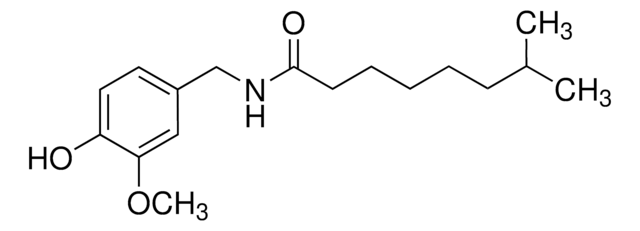M1022
Dihydrocapsaicin
from Capsicum sp., ≥85% (HPLC), powder, VR1 vanilloid receptor agonist
Synonym(e):
6,7-Dihydrocapsaicin, 8-Methyl-nonansäure-vanillylamid, N-[(4-Hydroxy-3-methoxy-phenyl)-methyl]-8-methyl-nonenamid
About This Item
Empfohlene Produkte
product name
Dihydrocapsaicin, from Capsicum sp., ≥85%
Biologische Quelle
Capsicum sp.
Assay
≥85%
Lagertemp.
2-8°C
SMILES String
COc1cc(CNC(=O)CCCCCCC(C)C)ccc1O
InChI
1S/C18H29NO3/c1-14(2)8-6-4-5-7-9-18(21)19-13-15-10-11-16(20)17(12-15)22-3/h10-12,14,20H,4-9,13H2,1-3H3,(H,19,21)
InChIKey
XJQPQKLURWNAAH-UHFFFAOYSA-N
Angaben zum Gen
human ... TRPV1(7442)
rat ... Trpv4(66026)
Suchen Sie nach ähnlichen Produkten? Aufrufen Leitfaden zum Produktvergleich
Anwendung
- as a standard to analyze the level of dihydrocapsaicin in endogenous An2 and capsaicin synthase silenced fruits
- as an external standard to determine the variability in capsaicinoid content in different landraces of capsicum
- in the activation or ablation of capsaicin-sensitive primary afferents (CSPA) fibres
Biochem./physiol. Wirkung
Verlinkung
Signalwort
Danger
H-Sätze
Gefahreneinstufungen
Acute Tox. 2 Oral - Eye Irrit. 2 - Skin Irrit. 2 - STOT SE 3
Zielorgane
Respiratory system
Lagerklassenschlüssel
6.1A - Combustible acute toxic Cat. 1 and 2 / very toxic hazardous materials
WGK
WGK 3
Flammpunkt (°F)
Not applicable
Flammpunkt (°C)
Not applicable
Persönliche Schutzausrüstung
Eyeshields, Faceshields, Gloves, type P2 (EN 143) respirator cartridges
Analysenzertifikate (COA)
Suchen Sie nach Analysenzertifikate (COA), indem Sie die Lot-/Chargennummer des Produkts eingeben. Lot- und Chargennummern sind auf dem Produktetikett hinter den Wörtern ‘Lot’ oder ‘Batch’ (Lot oder Charge) zu finden.
Besitzen Sie dieses Produkt bereits?
In der Dokumentenbibliothek finden Sie die Dokumentation zu den Produkten, die Sie kürzlich erworben haben.
Kunden haben sich ebenfalls angesehen
Unser Team von Wissenschaftlern verfügt über Erfahrung in allen Forschungsbereichen einschließlich Life Science, Materialwissenschaften, chemischer Synthese, Chromatographie, Analytik und vielen mehr..
Setzen Sie sich mit dem technischen Dienst in Verbindung.






